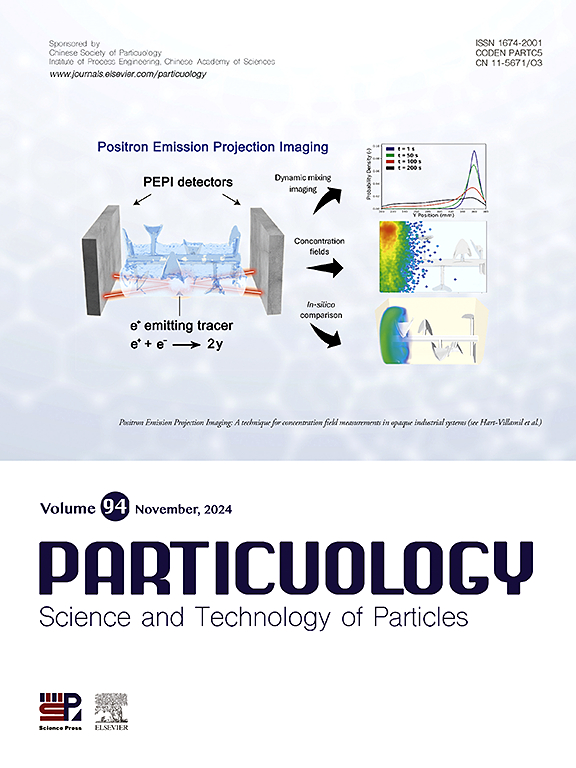Morphological observation and mineralogical analysis of basaltic debris from a Chang'e-5 drilled lunar soil sample
IF 4.1
2区 材料科学
Q2 ENGINEERING, CHEMICAL
引用次数: 0
Abstract
This paper analyzes the morphological characteristics and mineralogy of drilled basaltic clast sample CE5Z0806YJYX004, compares the variations in Chang'e-5 samples at different depths, and conducts a comparative analysis with surface-collected samples from Chang'e-5 and Apollo missions. Interestingly, Advanced electron microscopy identified bubbles and microcracks on the surface of some constituting mineral particles, and also displays crystalline particles with distinct rock textures and spherical droplets, revealing surface phenomena formed by space weathering. Based on Raman spectroscopy analysis, the main mineral phases were identified as 49.6 vol% pyroxene, 31.4 vol% plagioclase and 8.8 vol% olivine. Apatite, ilmenite and cristobalite are also found. The results indicate that the Chang'e-5 lunar soil exhibits similar mineral compositions at different depths. In short, a comparison was made between our drilling sample and the Chang'e-5 soil samples as well as samples from the Apollo mission series, demonstrating the physical similarities and some variations.

“嫦娥五号”月壤钻孔玄武岩碎屑形态观察及矿物学分析
分析了CE5Z0806YJYX004玄武岩岩屑钻孔样的形态特征和矿物学特征,对比了“嫦娥五号”不同深度样品的变化,并与“嫦娥五号”和“阿波罗”任务的地表采集样进行了对比分析。有趣的是,先进的电子显微镜在一些构成矿物颗粒的表面发现了气泡和微裂缝,还显示了具有独特岩石纹理的晶体颗粒和球形液滴,揭示了空间风化形成的表面现象。通过拉曼光谱分析,鉴定出主要矿物相为辉石49.6%,斜长石31.4%,橄榄石8.8 %。还发现了磷灰石、钛铁矿和方英石。结果表明,“嫦娥五号”月球土壤在不同深度表现出相似的矿物组成。简而言之,我们的钻孔样本与嫦娥五号以及阿波罗任务系列的土壤样本进行了比较,显示了物理上的相似性和一些差异。
本文章由计算机程序翻译,如有差异,请以英文原文为准。
求助全文
约1分钟内获得全文
求助全文
来源期刊

Particuology
工程技术-材料科学:综合
CiteScore
6.70
自引率
2.90%
发文量
1730
审稿时长
32 days
期刊介绍:
The word ‘particuology’ was coined to parallel the discipline for the science and technology of particles.
Particuology is an interdisciplinary journal that publishes frontier research articles and critical reviews on the discovery, formulation and engineering of particulate materials, processes and systems. It especially welcomes contributions utilising advanced theoretical, modelling and measurement methods to enable the discovery and creation of new particulate materials, and the manufacturing of functional particulate-based products, such as sensors.
Papers are handled by Thematic Editors who oversee contributions from specific subject fields. These fields are classified into: Particle Synthesis and Modification; Particle Characterization and Measurement; Granular Systems and Bulk Solids Technology; Fluidization and Particle-Fluid Systems; Aerosols; and Applications of Particle Technology.
Key topics concerning the creation and processing of particulates include:
-Modelling and simulation of particle formation, collective behaviour of particles and systems for particle production over a broad spectrum of length scales
-Mining of experimental data for particle synthesis and surface properties to facilitate the creation of new materials and processes
-Particle design and preparation including controlled response and sensing functionalities in formation, delivery systems and biological systems, etc.
-Experimental and computational methods for visualization and analysis of particulate system.
These topics are broadly relevant to the production of materials, pharmaceuticals and food, and to the conversion of energy resources to fuels and protection of the environment.
 求助内容:
求助内容: 应助结果提醒方式:
应助结果提醒方式:


